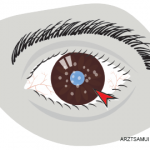Dr. Berkenstock noted that if scleral perforation or extensive thinning exists and there is a high risk of scleral rupture, surgery may be necessary.
Acute Anterior Uveitis
In ankylosing spondylitis, a strong association with both HLA-B27 positivity and acute anterior uveitis exists. This form of uveitis can recur or become chronic, may present bilaterally or alternate between eyes, and can occur simultaneously with scleritis. The classic presentation of acute anterior uveitis is eye redness, pain, blurred vision and photophobia.
Screening for Lyme disease, sarcoidosis and syphilis in these patients is important, according to Dr. Berkenstock. Also, RA and systemic lupus erythematosus can, rarely, present with acute anterior uveitis. Treatment of this condition includes topical glucocorticoids; posterior sub-tenon injection with triamcinolone acetonide or other medication; and, in cases of chronic anterior uveitis or in patients who do not tolerate local therapy, oral glucocorticoids and immunomodulators may be appropriate.
The prognosis for these patients tends to be good, with the average episode lasting six weeks or less. However, complications, such as cataracts, macular edema, glaucoma, corneal decompensation, hypotony or phthisis, may occur.
In sarcoidosis, the eye is one of the most commonly affected organs, & ocular manifestations include granulomatous uveitis, inflammatory glaucoma, optic neuropathy or granulomatous infiltration, & more.
Sarcoidosis
In sarcoidosis, the eye is one of the most commonly affected organs, and ocular manifestations can include granulomatous uveitis, inflammatory glaucoma, optic neuropathy or granulomatous infiltration, and lacrimal gland enlargement with sicca syndrome.
In granulomatous uveitis, the patient may present with mutton fat precipitates on the corneal endothelium. This condition usually involves both eyes in a progressive fashion. Patients may also demonstrate periphlebitis, which is common in the peripheral retina, with perivascular sheathing and severe vasculitis associated with extensive perivascular exudates. Patients whose eyes are subject to these changes may experience venous occlusion and neovascularization.
In patients with granulomatous inflammation of the optic nerve, the optic disc may have a characteristic lumpy and white appearance. Fortunately, recovery of vision for patients with granulomatous inflammation of the optic nerve can be rapid and significant if corticosteroids are started in a timely manner. These patients should also undergo neuroimaging to evaluate central nervous system involvement.
Medications Linked to Uveitis
Medications associated with uveitis include TNF inhibitors, bisphosphonates, oral contraceptives, sildenafil, sulfas, rifabutin, quinidine and clomiphene. Fluoroquinolones may also be associated with uveitis.
Various vaccines have also been associated with the development of uveitis, including those for influenza, hepatitis B, measles/mumps/rubella (MMR), diphtheria/pertussis/tetanus (DPT), varicella and the bacille Calmette-Guerin (BCG) vaccine for tuberculosis. Although more data are needed, reports also exist of patients presenting with uveitis after vaccination against COVID-19.1


